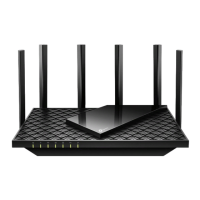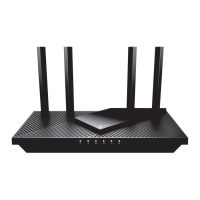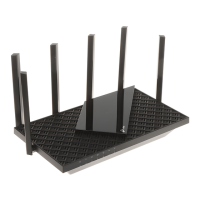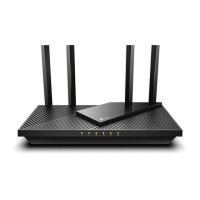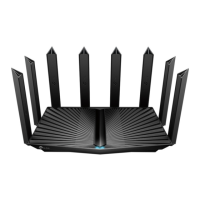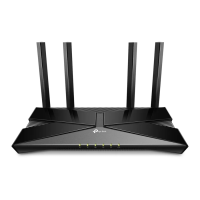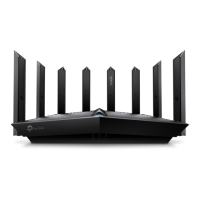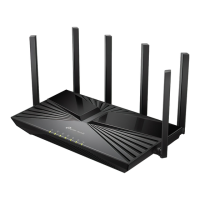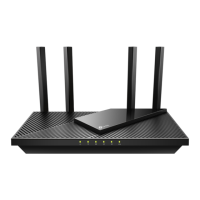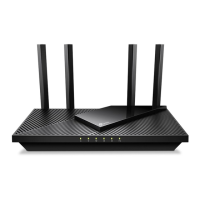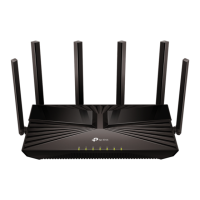Do you have a question about the TP-Link Archer AX80 and is the answer not in the manual?
Explains the router's features and capabilities, including Wi-Fi 6 technology.
Details the router's physical design and components, including front and back panels.
Provides guidance on optimal placement for the router to ensure good signal and connectivity.
Step-by-step instructions for physically connecting the router to your modem and power source.
Guides users on how to access the router's web management interface for configuration.
Walks users through the automated process of configuring internet connection settings.
Describes how to use the mobile app for a simplified internet setup process.
Provides instructions for manually configuring internet connection details based on ISP information.
Explains how to reconfigure the router to function as an Access Point for an existing network.
Details the steps for configuring the router to use an IPv6 internet connection.
Guides users on creating a TP-Link ID for cloud-based management and services.
Instructions for updating the email address and password associated with a TP-Link ID.
Explains how to add or remove TP-Link IDs for managing the router.
Describes how to use the Tether app to monitor and manage the router remotely.
Provides an overview of the network topology, showing connected devices and their status.
Details how to customize wireless network name (SSID), password, and security settings.
Allows users to set a schedule for automatically turning the wireless network on or off.
Explains how to use Wi-Fi Protected Setup (WPS) for easy and secure wireless connections.
Guides on setting up a separate Wi-Fi network for guests to enhance security and privacy.
Describes how to configure guest network permissions, like allowing guests to see each other.
Instructions on connecting and accessing files stored on USB devices attached to the router.
Explains how to share media files from a USB device for playback on DLNA-compatible devices.
Details how to configure the router for Time Machine backups from Mac computers.
Introduces HomeShield features for protecting the network against malicious attacks and intrusions.
Explains how to set restrictions on internet access for family members, including time limits.
Covers tools for analyzing network performance, quality of service, and generating reports.
Guides on creating a unified Wi-Fi network using TP-Link OneMesh routers and extenders.
Describes how to view and manage devices connected within the OneMesh network.
Details the SPI Firewall for protecting the router and network from unauthorized access and threats.
Explains how to block or allow specific devices to access the network using blacklists or whitelists.
Describes how to bind IP addresses to MAC addresses to prevent ARP spoofing and attacks.
Discusses Application Layer Gateway (ALG) settings for supporting various network protocols.
Provides steps for setting up an OpenVPN server on the router for secure remote access.
Details how to set up a PPTP VPN server for remote access to the home network.
Explains the configuration for L2TP/IPSec VPN server for secure remote access.
Guides on configuring the router as a VPN client to access remote VPN servers.
Explains how to make local network services accessible over the internet via port forwarding.
Describes how to dynamically open ports for specific applications based on triggering ports.
Details how to configure a DMZ host to bypass port restrictions for applications.
Explains how to use UPnP to ensure smooth online gaming experiences by opening necessary ports.
Provides instructions for modifying internet connection type, MAC address, and port settings.
Guides on changing the router's LAN IP address and subnet mask for network configuration.
Explains how to combine multiple LAN ports for increased bandwidth and network stability.
Details how to set up the router for Internet/IPTV/Phone services based on ISP requirements.
Covers configuring the DHCP server, including IP address pools and reservations for clients.
Guides on configuring DDNS to access the router and local servers using a domain name.
Explains how to manually configure static routes for specific network traffic forwarding.
Instructions for updating the router's firmware via auto-update, online, or local upgrade methods.
Details how to back up and restore router configuration settings, and reset to factory defaults.
Guides on changing the router's web management login password for enhanced security.
Explains how to set up and use the password recovery feature in case the login password is forgotten.
Covers settings for managing the router's access from the local network, including HTTPS support.
Explains how to enable and configure remote access to manage the router over the internet.
Guides on saving and viewing system logs for troubleshooting and monitoring router activities.
Details how to use diagnostic tools like Ping and Traceroute to test network connectivity.
Explains how to configure the router's system time from the internet, computer, or manually.
Describes how to schedule automatic reboots for the router to maintain performance.
Guides on using the Night Mode feature to turn off router LEDs during specified time periods.
Solutions for forgetting the wireless network password and how to retrieve or reset it.
Provides steps for recovering or resetting the web management login password.
Troubleshooting steps to resolve issues when unable to access the router's web management interface.
Solutions for troubleshooting internet connectivity problems after initial configuration.
Steps to resolve issues with finding or connecting to the wireless network.
Explains the router's features and capabilities, including Wi-Fi 6 technology.
Details the router's physical design and components, including front and back panels.
Provides guidance on optimal placement for the router to ensure good signal and connectivity.
Step-by-step instructions for physically connecting the router to your modem and power source.
Guides users on how to access the router's web management interface for configuration.
Walks users through the automated process of configuring internet connection settings.
Describes how to use the mobile app for a simplified internet setup process.
Provides instructions for manually configuring internet connection details based on ISP information.
Explains how to reconfigure the router to function as an Access Point for an existing network.
Details the steps for configuring the router to use an IPv6 internet connection.
Guides users on creating a TP-Link ID for cloud-based management and services.
Instructions for updating the email address and password associated with a TP-Link ID.
Explains how to add or remove TP-Link IDs for managing the router.
Describes how to use the Tether app to monitor and manage the router remotely.
Provides an overview of the network topology, showing connected devices and their status.
Details how to customize wireless network name (SSID), password, and security settings.
Allows users to set a schedule for automatically turning the wireless network on or off.
Explains how to use Wi-Fi Protected Setup (WPS) for easy and secure wireless connections.
Guides on setting up a separate Wi-Fi network for guests to enhance security and privacy.
Describes how to configure guest network permissions, like allowing guests to see each other.
Instructions on connecting and accessing files stored on USB devices attached to the router.
Explains how to share media files from a USB device for playback on DLNA-compatible devices.
Details how to configure the router for Time Machine backups from Mac computers.
Introduces HomeShield features for protecting the network against malicious attacks and intrusions.
Explains how to set restrictions on internet access for family members, including time limits.
Covers tools for analyzing network performance, quality of service, and generating reports.
Guides on creating a unified Wi-Fi network using TP-Link OneMesh routers and extenders.
Describes how to view and manage devices connected within the OneMesh network.
Details the SPI Firewall for protecting the router and network from unauthorized access and threats.
Explains how to block or allow specific devices to access the network using blacklists or whitelists.
Describes how to bind IP addresses to MAC addresses to prevent ARP spoofing and attacks.
Discusses Application Layer Gateway (ALG) settings for supporting various network protocols.
Provides steps for setting up an OpenVPN server on the router for secure remote access.
Details how to set up a PPTP VPN server for remote access to the home network.
Explains the configuration for L2TP/IPSec VPN server for secure remote access.
Guides on configuring the router as a VPN client to access remote VPN servers.
Explains how to make local network services accessible over the internet via port forwarding.
Describes how to dynamically open ports for specific applications based on triggering ports.
Details how to configure a DMZ host to bypass port restrictions for applications.
Explains how to use UPnP to ensure smooth online gaming experiences by opening necessary ports.
Provides instructions for modifying internet connection type, MAC address, and port settings.
Guides on changing the router's LAN IP address and subnet mask for network configuration.
Explains how to combine multiple LAN ports for increased bandwidth and network stability.
Details how to set up the router for Internet/IPTV/Phone services based on ISP requirements.
Covers configuring the DHCP server, including IP address pools and reservations for clients.
Guides on configuring DDNS to access the router and local servers using a domain name.
Explains how to manually configure static routes for specific network traffic forwarding.
Instructions for updating the router's firmware via auto-update, online, or local upgrade methods.
Details how to back up and restore router configuration settings, and reset to factory defaults.
Guides on changing the router's web management login password for enhanced security.
Explains how to set up and use the password recovery feature in case the login password is forgotten.
Covers settings for managing the router's access from the local network, including HTTPS support.
Explains how to enable and configure remote access to manage the router over the internet.
Guides on saving and viewing system logs for troubleshooting and monitoring router activities.
Details how to use diagnostic tools like Ping and Traceroute to test network connectivity.
Explains how to configure the router's system time from the internet, computer, or manually.
Describes how to schedule automatic reboots for the router to maintain performance.
Guides on using the Night Mode feature to turn off router LEDs during specified time periods.
Solutions for forgetting the wireless network password and how to retrieve or reset it.
Provides steps for recovering or resetting the web management login password.
Troubleshooting steps to resolve issues when unable to access the router's web management interface.
Solutions for troubleshooting internet connectivity problems after initial configuration.
Steps to resolve issues with finding or connecting to the wireless network.
| Wireless Standard | Wi-Fi 6 (802.11ax) |
|---|---|
| Maximum Speed (5 GHz) | 4804 Mbps |
| LAN Ports | 4x Gigabit Ethernet |
| USB Ports | 1x USB 3.0 |
| Frequency Bands | 2.4 GHz, 5 GHz |
| Security | WPA3 |
| Features | OFDMA, MU-MIMO, Beamforming |
